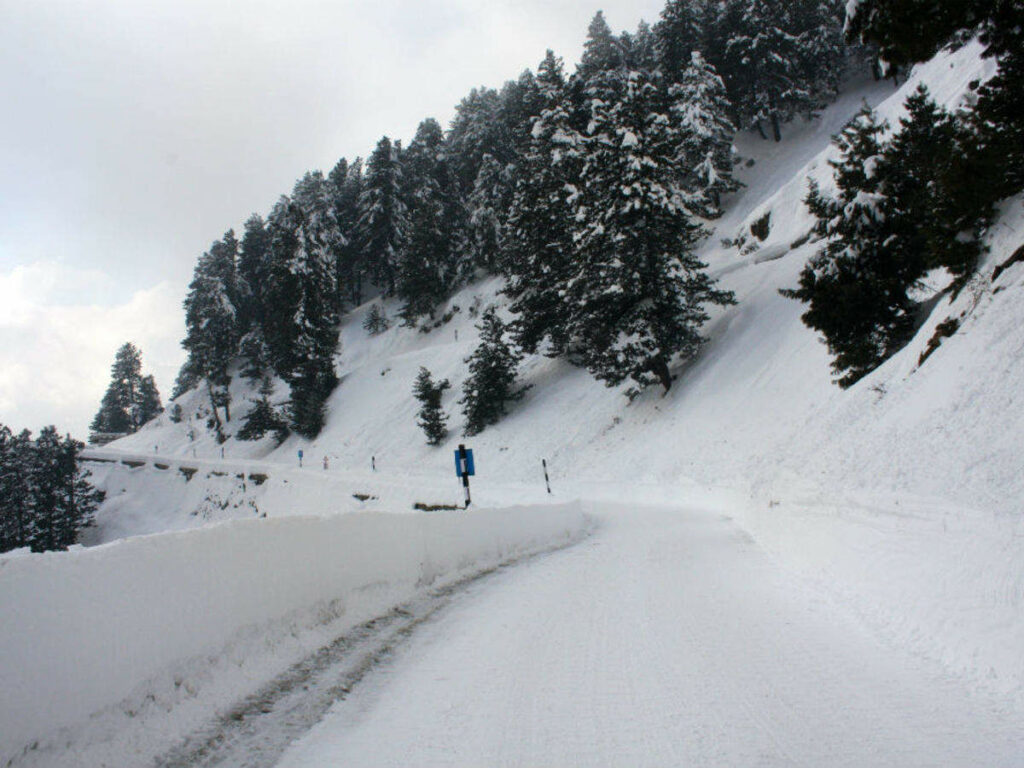Seasons of India
The climate of India consists of a wide range of weather conditions across a vast geographic scale and varied topography. India, a land of diverse landscapes and rich cultural heritage, experiences a delightful cycle of seasons throughout the year. From the scorching heat of summer to the chilling cold of winter, and everything in between, India’s seasons paint a vibrant canvas of nature’s wonders. Each season brings its own unique charm, festivities, and significance, making it an integral part of India’s cultural tapestry.
The climate of India can broadly be classified as a tropical monsoon one. The best way to define India’s climate is in terms of a yearly seasonal cycle. Seasons of India are majorly classified as Summer, Winter, Autumn, Spring and Monsoon seasons. However, The Indian Meteorological Department (IMD) designates four official seasons:
- Winter, from December to early April
- Summer or pre-monsoon, from April to June (April to July in north-western India)
- Monsoon or rainy, from June to September
- Post-monsoon, from October to December
Types of Seasons in India
The Seasons of India are majorly classified as Summer, Winter, Autumn, Spring and Monsoon seasons.
| Seasons Name | Months (around) |
|---|---|
| Spring Season (Vasant) | February to March |
| Summer Season (Grishma) | March to May |
| Monsoon Season (Varsha) | June to September |
| Autumn Season (Sharad) | October to November |
| Pre-Winter Season (Hemant) | December to January |
| Winter Season (Shishir) | January to February |
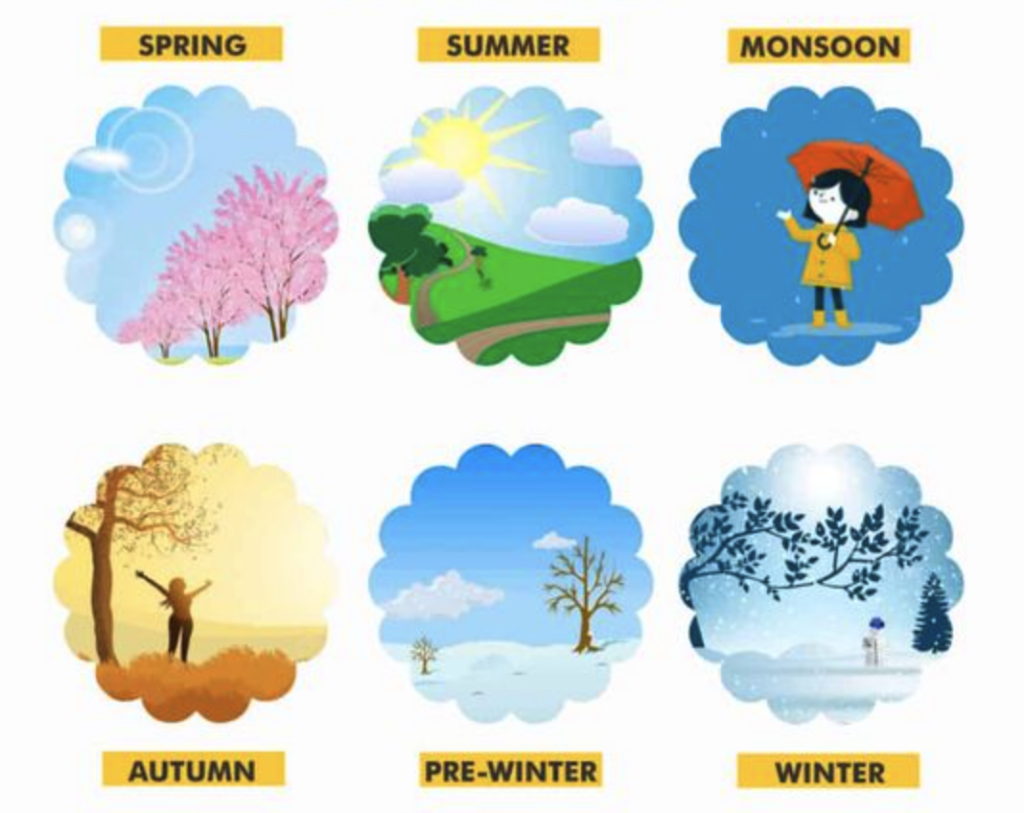
Spring Season (Vasant Ritu)
- The spring season in India is a season of two-month duration which is from February to March.
- It is a pleasant and beautiful season with an average temperature of 32 degree centigrade. It starts after the winter and lasts till summer starts.
- The day becomes longer and nights become shorter in this season.
- The people come out of the blankets and woollen clothes and start wearing light clothes. They are filled with excitement and happiness.
- The tree shed their leaves, new leaves start appearing. Birds and animals also love this season and are happy in this season. Birds start chirping, singing and butterflies start hovering over the flowers.
- Besides this, many famous Hindu festivals are celebrated in this season such as Holi, Vasant Panchami, Gudi Padwa, Baisakhi, Hanuman Jayanti, and more.
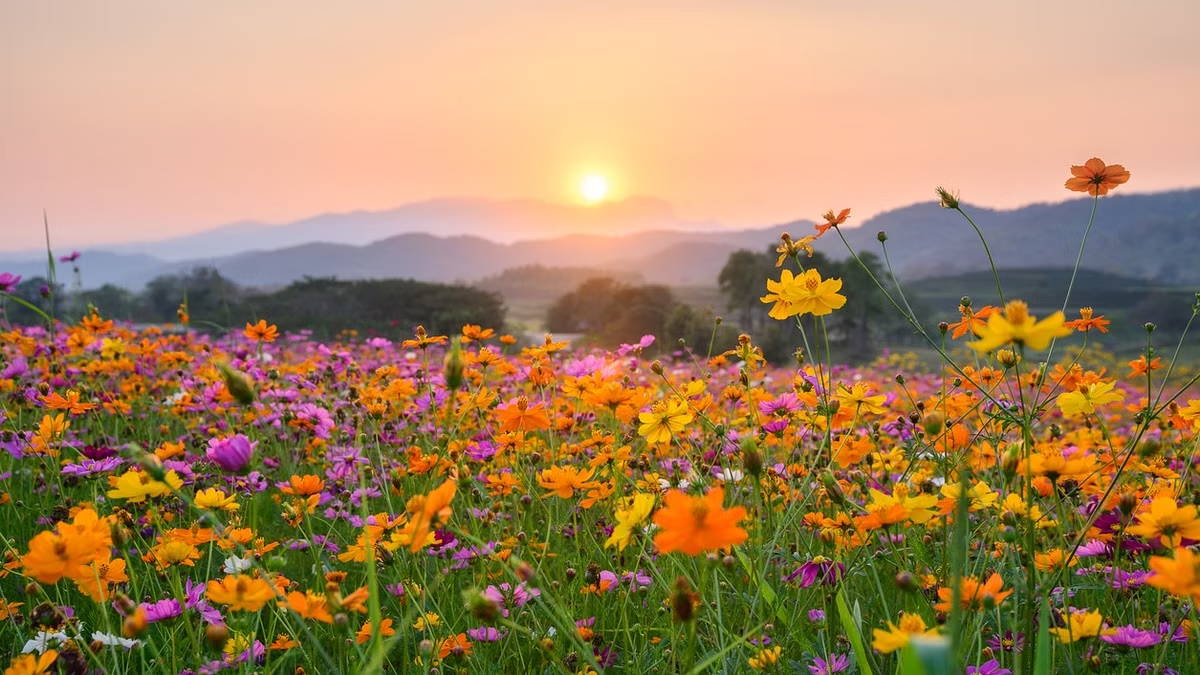
Summer Season (Grishma Ritu)
- Summer in northwestern India starts from April and ends in July, and in the rest of the country from March to May but sometimes lasts to mid June.
- This season is characterized mostly by high temperatures and little humidity. The temperatures in the north rise as the vertical rays of the Sun reach the Tropic of Cancer.
- The pre-monsoon season is another name for the hot weather season.
- There is a wide range of sun insolation because the sun appears to wander between the equator and the Tropic of Cancer.
- The southern regions of the nation are considerably warmer in March and April, while June brings greater temperatures to north India.
- The country’s southern regions record the highest temperatures in March (40–45°C).
- The highest temperature ever recorded in Madhya Pradesh’s northern regions was around 45°C in April.
- The hottest month is May when Rajasthan has had temperatures as high as 48°C.
- June is when temperatures are at their maximum in Punjab and Haryana.
- The two highest recorded temperatures were 50.6°C on June 14, 1935, at Ganganagar, and 50.5°C on May 10, 1956, in Alwar.
- Just before the onset of the southwest monsoon, the highest temperatures are recorded (late May).
- The temperature range throughout the day is likewise extremely wide.
- The mercury may rise as high as 18°C in some places.
- Maximum summer temperatures are noticeably lower in the coastal and southern peninsular regions due to the cooling impact of the sea.
- Temperatures on the west coast are typically cooler than those on the east coast due to the predominance of westerly winds.
- The temperatures at sea and on land are very different.
- In this season, heat waves struck the northern and central areas of India.
- Rajasthan, Punjab, and Haryana experience most of the heat waves (locations far away from the sea).
- From here, they expanded over Bihar and Uttar Pradesh.
- Heat waves in Odisha and Andhra Pradesh are brought on by strong northwesterly winds that are hindered from moving down the eastern coastal belt due to a high divergence in north-western India and a lengthy land journey over hot regions.
- Heat Waves start to appear towards the end of April, and their frequency peaks in May.
- They continue till the arrival of the southwest monsoon.
- In most cases, heat waves last four to five days.
- On the peninsula south of 13°N latitude, however, heat waves are rare because of the coastal climate that predominates there.
- Although this season may be annoying, it is good for the crops as they ripen only in the summer season. Also, there are lots of options in this season to stay hydrated and beat the heat such as watermelon, fruit juices, lassi, ice cream, lemon water, and more.
- The major Indian festival celebrated in the summer season are Guru Purnima and Rath Yatra.
Heat waves
- Heat waves are prolonged periods of excessively hot weather that can cause adverse impacts on human health, the environment, and the economy.
- India, being a tropical country, is particularly vulnerable to heat waves, which have become more frequent and intense in recent years.
- IMD Criteria for Declaring Heat Wave in India:
- Heat wave is considered if the maximum temperature of a station reaches at least 40°C or more for Plains and at least 30°C or more for Hilly regions.
- Based on Departure from Normal:
- Heat Wave: Departure from normal is 4.5°C to 6.4°C.
- Severe Heat Wave: Departure from normal is >6.4°C.
- Based on Actual Maximum Temperature:
- Heat Wave: When actual maximum temperature ≥ 45°C.
- Severe Heat Wave: When actual maximum temperature ≥47°C.
- Based on Departure from Normal:
- Heat wave is considered if the maximum temperature of a station reaches at least 40°C or more for Plains and at least 30°C or more for Hilly regions.
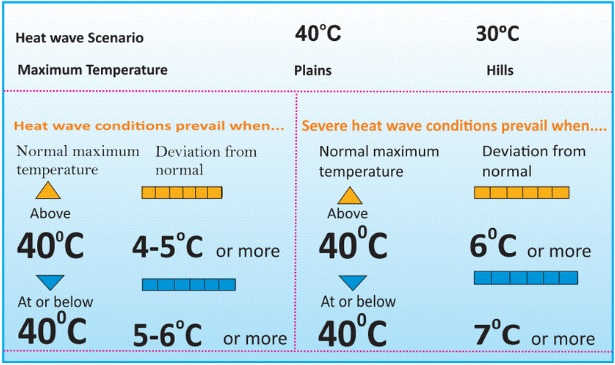
Monsoon Season in India
- The southwest summer monsoon, a four-month period when massive convective thunderstorms dominate India’s weather, is Earth’s most productive wet season.
- June to September is considered the Rainy Season or is called Monsoon in India.
- The significant increase in temperature across the northwest plains in May has intensified the low-pressure conditions there.
- By early June, they are strong enough to draw trade winds from the Indian Ocean that are native to the Southern Hemisphere.
- These trade winds from the southeast pass via the Arabian Sea and the Bay of Bengal after crossing the equator, only to be caught up in the airflow over India.
- As they cross the heated equatorial currents, they carry a lot of moisture with them.
- After crossing the equator, they proceed southwestward. As a result, the southwest monsoon is named.
- The important Hindu festivals that are celebrated in this season are Onam, Krishna Janmashtami, and Raksha Bandhan.
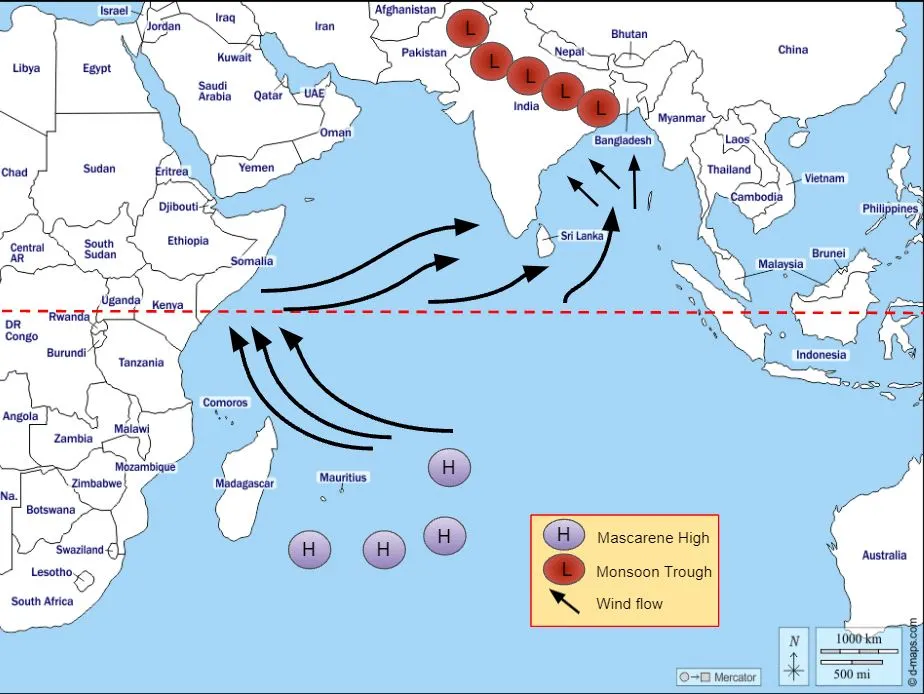
Southwest Monsoon Season
- The southwest monsoon season has a sudden onset of rain.
- The initial downpour has the impact of sharply decreasing the temperature. When the monsoons “break” or “burst,” winds carrying moisture accompanied by ferocious thunder and lightning, occur.
- The monsoon may begin in the first week of June in the coastal regions of Kerala, Karnataka, Goa, and Maharashtra while it may begin in the first week of July in the interior.
- The daily temperature drops from mid-June to mid-July by 5°C to 8°C.
- The southwesterly direction of these winds as they reach the land is modified by the relief and thermal low pressure over northwest India.
- As the mainland approaches, the monsoon splits into two branches:
- The Arabian Sea branch
- The Bay of Bengal branch
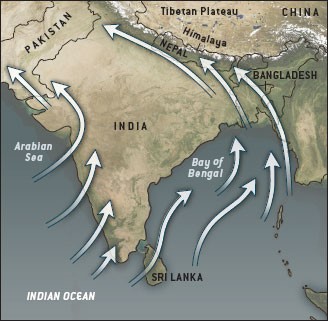
Retreating Monsoon Season or Cool Season
- In October and November, monsoons are known to retreat hence called Retreating Monsoons.
- The Ganga Plains low-pressure trough starts to travel southward towards the end of September in reaction to the sun’s southerly march, which weakens the southwest monsoon. Western Rajasthan is free of the monsoon by the first week of September. It will have left Rajasthan, Gujarat, the Western Ganga Plain, and the Central Highlands by the end of the month.
Retreating Monsoon in Southern Half of India
- By early October, the low-pressure system had moved across the northern portions of the Bay of Bengal, and by early November it was over Karnataka and Tamil Nadu. By the middle of December, the area of low pressure will be entirely gone from the Peninsula.
- The southwest monsoon season is ending as the weather becomes clearer and warmer. The soil is still drenched.
- The high warmth and humidity make the weather uncomfortable. The term “October heat” is used to describe this.
Retreating Monsoon in the Northern Half of India
- In the second half of October, temperatures start to rapidly fall, particularly in northern India. While the eastern section of the Peninsula has rained during the retreating monsoon, and the weather in north India remains dry. In this region, October and November are the wettest months of the year.
- Cyclonic depressions that develop over the Andaman Sea and travel to the eastern coast of the southern Peninsula are associated with the arrival of the rainy season.
Retreating Monsoons Effects
- These tropical cyclones pose a serious threat. The crowded deltas of the Godavari, Krishna, and Kaveri rivers are their favoured prey. These cyclones wreak havoc in this region every year.
- There have also been cyclonic storms that have impacted the shores of West Bengal, Bangladesh, and Myanmar.
- Most of the rainfall on the Coromandel Coast is caused by these depressions and cyclones. Such cyclonic storms are less common in the Arabian Sea.
Autumn (Sharad Ritu)
- The season of autumn comes in the months of September and October. The hot and humid weather starts disappearing and leaves start falling off the trees in this season, so it is also known as the fall season.
- The sky becomes clearer as compared to the monsoon season and clear moon can be seen in the sky along with countless starts that look like pearls scattered in the sky.
- The water of the rivers and ponds settle down and becomes clean and there is no mud in the villages. The insects and mites gradually start disappearing with the arrival of autumn.
- It starts after the monsoon or rainy season and lasts till the start of the pre-winter season. The average temperature in this season remains around 33 degree centigrade.
- The length of the day and night is almost equal in this autumn. Equinoxes also occur in this season. It is an event in which the Earth’s axis is titled in a way that it is neither inclined towards nor away from the Sun.
- The major Hindu festivals that are celebrated in this season are Navaratri in which Hindu devotees worship the nine different forms of Goddess Shakti, Sharad Purnima which is celebrated as the harvest festival, and Vijayadashami (Dussera) to celebrate the victory of Ram over Ravana.
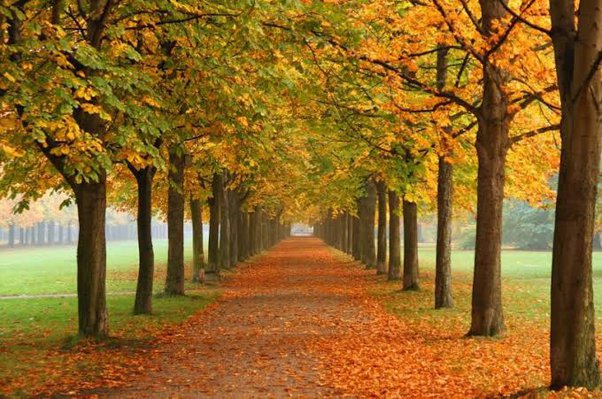
Pre-winter
- Pre-winter is the season after autumn and before the winter season. Pre-winter is a time of transition in India.
- This season comes in the months of November and December. It starts with the end of October and lasts till the start of winter season or January. So, it precedes the winter season.
- This season is moderately cold with an average temperature of around 27 degree centigrade. It is the transition from autumn to winter and is the most pleasant and enjoyable time of the year. The days become shorter than nights and the nights are foggy, colder. Rainfall is occasional in this season.
- The trees in the Mountains and hills start shedding their ripe leaves to reduce evaporation of trees to compensate the loss of water. However, soon the trees are loaded with new leaves and flowers. So, it gives the message of leaving the old temptation and go for newness or innovation. Winter sports of national and international level are organized in this season.
- The flowers that bloom in this season are Hibiscus, Rose, Bougainvillea, Jasmine, and more.
- The important Hindu festivals which are celebrated in this season include Diwali and Bhai Dooj.
- As per Hindu calendar, these months are known as Agrahayana and Pausha, or Agahan and Poos.
- Besides so many benefits, there are also a few things that are not liked in this season. Such as diseases like cough, asthma, cold start appearing and infecting the people.
- Due to low rainfall, some crops may get spoiled and crops and vegetables may rot due to fog and frost.

Winter Season
- Mid-December through mid-March is considered the Winter Season in India .
- South of the equator is where the sun appears to be travelling.
- This season is marked by clear skies, pleasant weather, cold and gentle northeast trade breezes, low temperatures, low humidity, and a wide variety of temperatures.
- Particularly during the winter months in the interior of the nation, the diurnal temperature variation is incredibly wide.
- The 20°C isotherms and the Tropic of Cancer are nearly parallel. To the south of this isotherm, temperatures are higher than 20 °C.
- There is no distinct winter climate in this area. In some areas of Tamil Nadu and Kerala, the temperature frequently reaches 30 degrees.
- The north has distinct winter weather with an average temperature below 21°C.
- The Gangetic plains have a mean minimum temperature of about 10°C, compared to a mean minimum of about 5°C in north-western India.
- India’s coldest place is the Dras Valley in Kashmir. The lowest temperature ever at Dras was -45°C in 1908.
- The Kharif crops ripen in this season. A large variety of fruits, flowers and green vegetables are available in abundance in this season.
- Besides this, winter season in India starts with the winter solstice. It is a geographical event in which the sun is at the highest summit in the sky.
- The major Hindu festivals celebrated in winter season include Pongal, Shivratri, Lohri, and Pongal.
